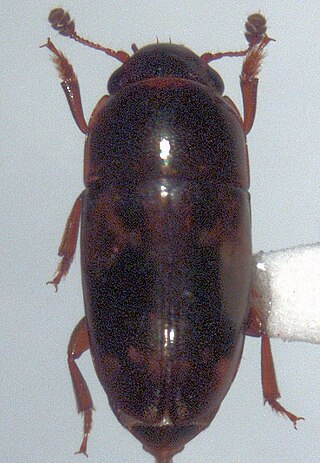
The crimson rosella is a parrot native to eastern and south eastern Australia which has been introduced to New Zealand and Norfolk Island. It is commonly found in, but not restricted to, mountain forests and gardens. The species as it now stands has subsumed two former separate species, the yellow rosella and the Adelaide rosella. Molecular studies show one of the three red-coloured races, P. e. nigrescens, is genetically more distinct.

The Pyrgotidae are an unusual family of flies (Diptera), one of only two families of Cyclorrhapha that lack ocelli. Most species are "picture-winged", as is typical among the Tephritoidea, but unlike other tephritoids, they are endoparasitoids; the females pursue scarab beetles in flight, laying an egg on the beetle's back under the elytra where the beetle cannot reach it. The egg hatches and the fly larva enters the body cavity of the beetle, feeding and eventually killing the host before pupating. In the United States, some species of Pyrgota and Sphecomyiella can be quite common in areas where their host beetles are abundant. Like their host beetles, these flies are primarily nocturnal, and are often attracted to artificial lights.

Melyridae are a family of beetles of the superfamily Cleroidea.
P. elegans may refer to any of the following species:

Cephalota elegans is a species in the tiger beetle family Cicindelidae. It is found in eastern Europe and western Asia, in the European-Siberian steppe.
Clivina elegans is a species in the beetle family Carabidae. It is found in Australia.
Catascopus elegans is a species in the beetle family Carabidae. It is found in Southeast Asia and Australia.
Tropidion is a genus of beetles in the family Cerambycidae, containing the following species:

Ceroplesis is a genus of flat-faced longhorn beetle in the subfamily Lamiinae of the family Cerambycidae.
Tropidion elegans is a species of beetle in the family Cerambycidae. It was described by Gounelle in 1909.
C. elegans most commonly refers to the model round worm Caenorhabditis elegans. It may also refer to any of the species below. They are listed, first in taxonomic order and, second, alphabetically.
Carenum elegans is a species of ground beetle in the subfamily Scaritinae, tribe Scaritini and subtribe Carenina. It was described by William John Macleay in 1864 from Port Denison, Western Australia.
Paropsimorpha elegans is a species of leaf beetle found in Australia.

Malachiinae is a subfamily of beetles of the family Melyridae and having a global distribution.

Carphurus is a genus of soft-wing flower beetles in the subfamily Malachiinae and tribe Carphurini. Species are found mainly in Australia, and in Papua-New Guinea.

Cryptarcha is a genus of sap beetles, insects in the family Nitidulidae.
Ochthephilum elegans is a species of rove beetles in the subfamily Paederinae. It is found in Australia.
Eupompha is a genus of blister beetles in the family Meloidae. There are about 14 described species in Eupompha.







